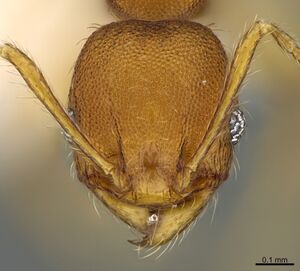Pheidole natalie
| Pheidole natalie | |
|---|---|

| |
| Scientific classification | |
| Kingdom: | Animalia |
| Phylum: | Arthropoda |
| Class: | Insecta |
| Order: | Hymenoptera |
| Family: | Formicidae |
| Subfamily: | Myrmicinae |
| Tribe: | Attini |
| Genus: | Pheidole |
| Species: | P. natalie |
| Binomial name | |
| Pheidole natalie Longino, 2019 | |
This species occurs in cloud forest habitats. It is common at baits on the forest floor and in Winkler samples. Three nests have been observed. One was in a small patch of exposed clay soil. Workers came to a bait from a small round entrance hole. Excavation was attempted, following a very small tunnel in clay. It meandered and was very difficult to follow. At about 20 cm deep a few adult males and a larva were discovered loose in the jumbled clay, presumably from a disrupted chamber. Nearby were a few major workers in part of the tunnel system. Workers seemed to be thinly spread in tiny tunnels in the clay and a distinct chamber was never uncovered. Another nest was observed in a trail-side clay wall, following minor and major workers that came to bait. The entrance was a small clay turret. A third nest was observed under a stone.
Identification
Minor: face and mesosoma uniformly foveolate, with variably developed small smooth area on lower margin of lateral pronotum; promesonotum evenly convex, promesonotal groove absent or very weakly impressed; propodeal spines one fourth to one third length of posterior face of propodeum; gaster smooth and shining; abundant erect setae on mesosomal dorsum and gaster; tibiae with 2-3 erect setae; color orange (or rarely bicolored; see Comments).
Major: inner hypostomal teeth stout, closely spaced; scape base terete; face with distinct scrobes, delimited dorsally by frontal carinae and forming concave trough below them, ventral and posterior margins less delimited, surface of scrobe smooth and shiny; head depressed posteriorly, forming transverse depression between frontal carinae and vertex lobes, particularly visible in profile; face surface generally shiny, space between frontal carinae smooth, space between eye and antennal fossa and vertex lobes with widely separated, subparallel, longitudinal carinae; propodeal spines one third length of posterior face of propodeum; gastral dorsum smooth and shining; sides of head with abundant erect setae; abundant flexuous erect setae on mesosomal dorsum, tibiae, and gaster.
Measurements, minor worker: HW 0.44, HL 0.48, SL 0.44, EL 0.10, WL 0.59, PSL 0.04, PTW 0.08, PPW 0.13, CI 93, SI 99, PSLI 9, PPI 159 (n=13).
Measurements, major worker: HW 0.88, HL 1.05, SL 0.44, EL 0.14, WL 0.86, PSL 0.07, PTW 0.18, PPW 0.32, CI 85, SI 50, PSLI 8, PPI 184 (n=10).
This species is part of a complex of species discussed under Pheidole andersoni. Three widely separated populations are here identified as P. natalie because they are morphologically very similar. The populations are a site in the Sierra Mazateca in Oaxaca, Mexico; Cusuco National Park in Honduras; and specimens from two sites in Nicaragua, Cerro Musún and Saslaya National Park. DNA barcodes closely cluster specimens from the two Nicaragua sites. However, there are no sequence data for specimens from Honduras and Mexico. Given the similarity of species across the complex, the three populations could easily be separate lineages that are not necessarily part of a single clade.
The population in Cusuco National Park in Honduras showed color polymorphism. At some baits the minor workers were all the usual uniform yellow orange. In others, minor workers showed the harlequin coloration of Pheidole balatro, which is sympatric at the site, and Pheidole zannia, which occurs in other parts of Honduras. Pheidole natalie and P. zannia are similar and probably closely related. One possibility is that there is introgression or hybrization between P. natalie and P. zannia, with Cusuco being a contact zone. One bait with a strong recruitment had both color forms, and there was intergradation to some extent.
Distribution
Mexico (Oaxaca) to Nicaragua
Distribution based on Regional Taxon Lists
Neotropical Region: Guatemala, Honduras, Mexico, Nicaragua (type locality).
Distribution based on AntMaps
Distribution based on AntWeb specimens
Check data from AntWeb
Countries Occupied
| Number of countries occupied by this species based on AntWiki Regional Taxon Lists. In general, fewer countries occupied indicates a narrower range, while more countries indicates a more widespread species. |

|
Estimated Abundance
| Relative abundance based on number of AntMaps records per species (this species within the purple bar). Fewer records (to the left) indicates a less abundant/encountered species while more records (to the right) indicates more abundant/encountered species. |

|
Biology
Castes
Worker
Minor
Images from AntWeb
   
| |
| Paratype Minor. Specimen code CASENT0628197. Photographer Michele Esposito. | |
Nomenclature
The following information is derived from Barry Bolton's Online Catalogue of the Ants of the World.
- natalie. Pheidole natalie Longino, 2019: 49, fig. 10 (w.) NICARAGUA.
Type Material
- HOLOTYPE: 1 major worker, Nicaragua, Jinotega: PN Cerro Saslaya, 13.76751 -85.02469 ±100 m, 1040 m, 14-May-2011, montane wet forest, at bait (LLAMA, Ba-D-03-1-02-07) [MCZC, unique specimen identifier CASENT0628205].
- PARATYPES: major, minor workers: same data as holotype [MCZC]; same data except Ba-D-03-1-02-04 [CAS]; Ba-D-03-1-02-11 [DZUP]; Ba-D-03-1-02-15 [JTLC]; 13.76837 -85.02436 ±100 m (Ba-D-03-1-01-15) [USNM].
Description
Etymology
In honor of Natalie Vandeven Longino, the newest member of the family.
References
References based on Global Ant Biodiversity Informatics
- Longino J. T. 2019. Pheidole (Hymenoptera, Formicidae) of Middle American wet forest. Zootaxa 4599: 1-126

